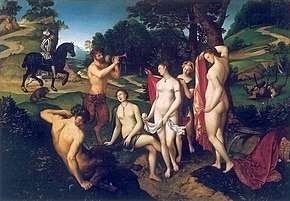Le Bain de Diane
Le Bain de Diane (The Bath of Diana) is a French 1550s painting attributed to François Clouet, located in the Musée des Beaux-Arts, Rouen.[1] According to Eckhardt Knab, writing in The Dictionary of Art, it is an example of an allegorical landscape and refers to the marriage of Francis II and Mary Stuart. Clouet's painting reveals influences by, but tempers the overdrawn Mannerist bodily forms of several artists of the School of Fontainebleau, such as Rosso Fiorentino, Francesco Primaticcio, and Nicolo dell'Abate, and its landscape reflects the work of Giorgione and early Titian.[2]

Le Bain de Diane by François Clouet
Notes
- Blunt 1953, p. 247, note 101.
- Knab 1996.
Bibliography
- Blunt, Anthony (1953). Art and Architecture in France 1500-1700. London: Penguin Books. OCLC 1123985395.
- Knab, Eckhart (1996). "François Clouet", vol. 7, pp. 464–466, in The Dictionary of Art, 34 volumes, edited by Jane Turner. New York: Grove. ISBN 9781884446009.
gollark: If building materials were better and construction a lot cheaper and more efficient, you could plausibly leverage vertical space and make cities much denser without compromising on available living space much.
gollark: I mean, any random stupid office thing can be done from anywhere and might just be automated anyway.
gollark: A lot *can* though.
gollark: Some employers have realized that they *can* do remote work, and I imagine this will increase as the technology improves.
gollark: If people don't need to physically be somewhere to do work, they have more options.
This article is issued from Wikipedia. The text is licensed under Creative Commons - Attribution - Sharealike. Additional terms may apply for the media files.